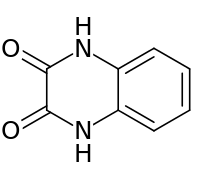Quinoxalinedione
Quinoxalinedione
 |
| Identifiers |
| |
15804-19-0 |
| Properties |
| |
C8H6N2O2 |
| Molar mass |
162.15 |
| Appearance |
white solid |
| Density |
1.549 g/cm3 |
| Melting point |
> 300 C |
Except where noted otherwise, data is given for materials in their standard state (at 25 °C (77 °F), 100 kPa) |
|
| Infobox references |
|
|
Quinoxalinedione is an organic compound with the formula C6H4(NH)2(CO)2. It is a colorless solid that is soluble in polar organic solvents. Quinoxalinediones are a family of related compounds sharing the same bicyclic core. Various quinoxalinediones are drugs.
Synthesis and structure
Quinoxalinedione is produced by condensatoin of dimethyloxalate and o-phenylenediamine:
- C2O2(OMe)2 + C6H4(NH2)2 → C6H4(NH)2(CO)2 + 2 MeOH
The compound exists in solution and the solid state predominantly as the diamide form.[1] Some reactions of the compound indicate a role for the diol tautomer.
Drugs based on quinoxalinediones
Quinoxalinediones act as antagonists of the AMPA, kainate, and/or NMDA receptors of the ionotropic glutamate receptor family.[2][3][4] Examples include the following:
A drug closely related to the quinoxalinediones, but possessing a quinazoline-2,4-dione structure instead, is selurampanel. Caroverine is another closely related drug to the above, but instead containing a quinoxaline-2-one structure.
References
- ↑ Saied M. Soliman, Jörg Albering, Morsy A.M. Abu-Youssef "Low temperature X-ray molecular structure, tautomerism and spectral properties of 2,3-dihydroxyquinoxaline" Journal of Molecular Structure 2013, vol. 1053, pp. 48–60. doi:10.1016/j.molstruc.2013.09.005
- ↑ Ashley, M.J. (2010). Traumatic Brain Injury: Rehabilitation, Treatment, and Case Management, Third Edition. CRC Press. p. 142. ISBN 978-1-4398-4982-8. Retrieved 2015-01-01.
- ↑ Turski, L.; Schoepp, D.D.; Cavalheiro, E.A. (2001). Excitatory Amino Acids: Ten Years Later. Biomedical and health research (in Italian). IOS Press. p. 38. ISBN 978-1-58603-072-8. Retrieved 2015-01-01.
- ↑ Offermanns, S.; Rosenthal, W. (2008). Encyclopedia of Molecular Pharmacology. Encyclopedia of Molecular Pharmacology (v. 1). Springer. p. 660. ISBN 978-3-540-38916-3. Retrieved 2015-01-01.
Glutamatergics |
|---|
| Receptor
(ligands) | | AMPA | |
|---|
| | NMDA |
- Antagonists: Competitive antagonists: AP5 (APV)
- AP7
- CGP-37849
- CGP-39551
- CGP-39653
- CGP-40116
- CGS-19755
- CPP
- LY-233,053
- LY-235,959
- LY-274,614
- MDL-100,453
- Midafotel (d-CPPene)
- NPC-12,626
- NPC-17,742
- PBPD
- PEAQX
- Perzinfotel
- PPDA
- SDZ-220581
- Selfotel; Noncompetitive antagonists: ARR-15,896
- Caroverine
- Dexanabinol
- FPL-12495
- FR-115,427
- Hodgkinsine
- Magnesium
- MDL-27,266
- NPS-1506
- Psychotridine
- Zinc; Uncompetitive pore blockers: 2-MDP
- 3-MeO-PCP
- 8A-PDHQ
- 18-MC
- α-Endopsychosin
- Alaproclate
- Amantadine
- Aptiganel
- ARL-12,495
- ARL-15,896-AR
- ARL-16,247
- Budipine
- Conaridine
- Delucemine
- Dexoxadrol
- Dextrallorphan
- Dieticyclidine
- Dizocilpine
- Esketamine
- Etoxadrol
- Eticyclidine
- Gacyclidine
- Ibogaine
- Ibogamine
- Indantadol
- Ketamine
- Ketobemidone
- Lanicemine
- Loperamide
- Memantine
- Methadone (Levomethadone)
- Methorphan (Dextromethorphan
- Levomethorphan)
- Methoxetamine
- Methoxphenidine
- Milnacipran
- Morphanol (Dextrorphan
- Levorphanol)
- NEFA
- Neramexane
- Nitromemantine
- Nitrous oxide
- Noribogaine
- Orphenadrine
- PCPr
- Pethidine (meperidine)
- Phencyclamine
- Phencyclidine
- Propoxyphene
- Remacemide
- Rhynchophylline
- Rimantadine
- Rolicyclidine
- Sabeluzole
- Tabernanthine
- Tenocyclidine
- Tiletamine
- Tramadol
- Xenon; Glycine site antagonists: 7-CKA
- ACC
- ACEA-1011
- ACEA-1328
- AV-101
- Carisoprodol
- CGP-39653
- CNQX
- DCKA
- DNQX
- Felbamate
- Gavestinel
- GV-196,771
- Kynurenic acid
- L-689,560
- L-701,324
- Licostinel (ACEA-1021)
- LU-73,068
- MDL-105,519
- Meprobamate
- MRZ 2/576
- PNQX
- ZD-9379; NR2B subunit antagonists: Besonprodil
- CERC-301 (MK-0657)
- CO-101,244 (PD-174,494)
- Eliprodil
- Haloperidol
- Ifenprodil
- Isoxsuprine
- Nylidrin
- Ro8-4304
- Ro25-6981
- Traxoprodil; Polyamine site antagonists: Arcaine
- Co 101676
- Diaminopropane
- Diethylenetriamine
- Huperzine A
- Putrescine
- Ro 25-6981; Unclassified/unsorted antagonists: Bumetanide
- Chloroform
- Cyclopropane
- D-αAA
- Diethyl ether
- Diphenidine
- Enflurane
- Ethanol
- Flufenamic acid
- Flupirtine
- Furosemide
- Halothane
- Isoflurane
- Metaphit
- Methoxyflurane
- Niflumic acid
- Piretanide
- Toluene
- Trichloroethane
- Trichloroethanol
- Trichloroethylene
- Xylene
|
|---|
| | Kainate | |
|---|
| | mGlu1 |
- Antagonists: BAY 36-7620
- CPCCOEt
- LY-367,385
- LY-456,236
- MCPG
- NPS-2390
|
|---|
| | mGlu2 | |
|---|
| | mGlu3 | |
|---|
| | mGlu4 |
- Agonists: Glutamate
- L-AP4
- PHCCC
- VU-001,171
- VU-0155,041; Positive allosteric modulators: MPEP
- Antagonists: CPPG
- MAP4
- MPPG
- MSOP
- MTPG
- UBP-1112
|
|---|
| | mGlu5 | |
|---|
| | mGlu6 |
- Agonists: Glutamate
- L-AP4
- Antagonists: CPPG
- MAP4
- MPPG
- MSOP
- MTPG
- UBP-1112
|
|---|
| | mGlu7 |
- Antagonists: CPPG
- MAP4
- MMPIP
- MPPG
- MSOP
- MTPG
- UBP-1112
|
|---|
| | mGlu8 |
- Antagonists: CPPG
- MAP4
- MPPG
- MSOP
- MTPG
- UBP-1112
|
|---|
|
|---|
| Transporter
(blockers) | |
|---|
| Enzyme
(inhibitors) | | GAH | |
|---|
| | AST |
- 2-Amino-3-butenoic acid
- AAOA
- AMB
- β-DL-Methylene-aspartate
- Hydrazinosuccinate
|
|---|
| | ALT |
- β-Chloro-L-alanine
- L-Cycloserine
- Propargylglycine
|
|---|
| | GDH | |
|---|
| | GS |
- 2-Aminoadipic acid
- JFD01307SC
- Methionine sulfoximine
- Phosphinothricin (glufosinate)
|
|---|
| | GAD | |
|---|
|
|---|
| | Others |
- Cofactors: α-Ketoglutaric acid
- Iron
- Sulfur
- Vitamin B2
- Vitamin B3
|
|---|
| See also: GABAergics • GHBergics • Glycinergics |
|
